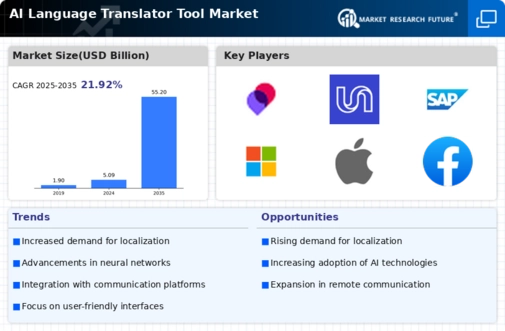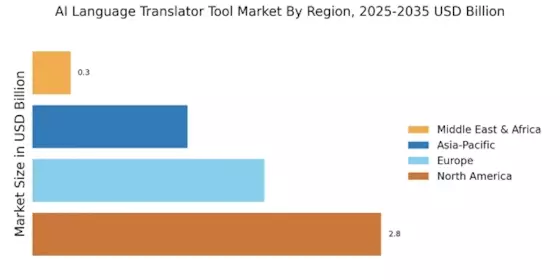North America : Innovation and Market Leadership
North America is the largest market for AI language translator tools, holding approximately 45% of the global market share. The region's growth is driven by high demand for advanced translation solutions in various sectors, including education, healthcare, and e-commerce. Regulatory support for AI technologies and increased investment in research and development further catalyze market expansion. The U.S. government actively promotes AI initiatives, enhancing the region's competitive edge.
The competitive landscape in North America is dominated by major players such as Google, Microsoft, and Amazon, which continuously innovate to enhance their offerings. The presence of these tech giants fosters a robust ecosystem for startups and smaller companies, contributing to a dynamic market environment. Additionally, the region benefits from a highly skilled workforce and significant funding for AI research, ensuring sustained growth in the AI language translation sector.
Europe : Regulatory Framework and Growth
Europe is witnessing significant growth in the AI language translator tool market, accounting for approximately 30% of the global share. The region's expansion is fueled by increasing demand for multilingual communication solutions, particularly in business and tourism sectors. Regulatory frameworks, such as the EU's Digital Single Market strategy, promote the adoption of AI technologies, ensuring compliance and fostering innovation across member states. This supportive environment is crucial for market growth.
Leading countries in Europe include Germany, France, and the UK, where companies like DeepL and SYSTRAN are making substantial contributions. The competitive landscape is characterized by a mix of established firms and innovative startups, all vying for market share. The presence of key players, along with a strong emphasis on data privacy and security, positions Europe as a significant player in the AI language translation market.
Asia-Pacific : Rapid Adoption and Innovation
Asia-Pacific is rapidly emerging as a powerhouse in the AI language translator tool market, holding around 20% of the global market share. The region's growth is driven by increasing internet penetration, mobile device usage, and a growing need for cross-border communication in trade and tourism. Countries like China and India are at the forefront, with government initiatives supporting AI development and integration into various sectors, enhancing market dynamics.
China, with key players like Baidu and iFLYTEK, leads the market, while India is witnessing a surge in startups focusing on AI solutions. The competitive landscape is vibrant, with both local and international companies striving to capture market share. The region's diverse linguistic landscape further fuels demand for effective translation tools, making it a critical area for future growth in the AI language translation sector.
Middle East and Africa : Emerging Market with Potential
The Middle East and Africa (MEA) region is an emerging market for AI language translator tools, currently holding about 5% of the global market share. The growth is driven by increasing digitalization, a rise in e-commerce, and the need for effective communication in diverse linguistic environments. Governments in the region are beginning to recognize the importance of AI technologies, leading to supportive policies that encourage innovation and investment in this sector.
Countries like South Africa and the UAE are leading the charge, with a growing number of startups and tech companies entering the market. The competitive landscape is evolving, with both local and international players seeking to establish a foothold. As the region continues to develop its digital infrastructure, the demand for AI language translation tools is expected to rise, presenting significant opportunities for growth.


















Leave a Comment